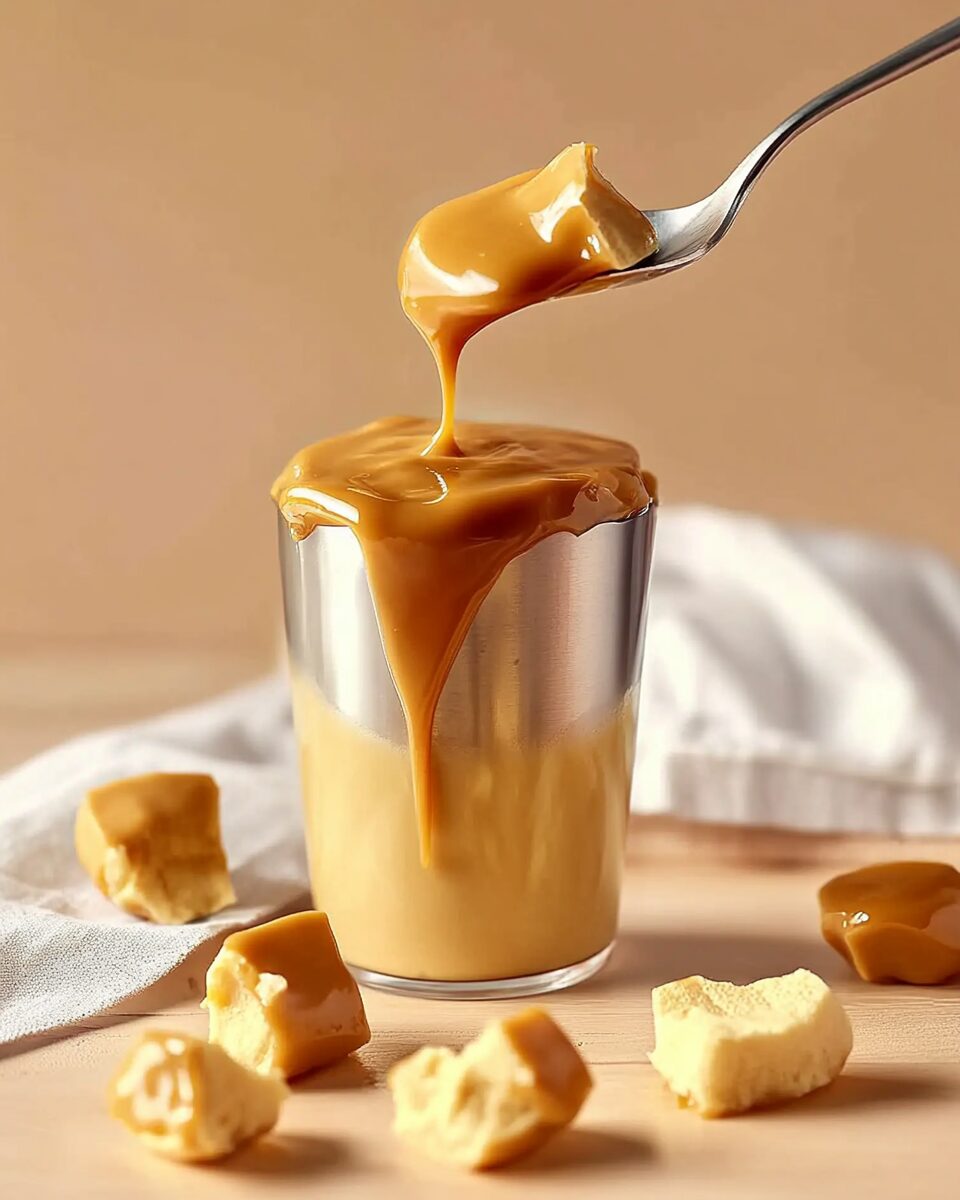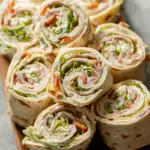This Slow Cooker Dulce de Leche is a luscious caramel sauce made with just one ingredient—sweetened condensed milk. After slow-cooking for hours, the result is a smooth, rich, and golden sauce perfect for drizzling over desserts, spreading on toast, or enjoying by the spoonful.
The beauty of this recipe lies in its simplicity and versatility. Whether you’re using it as a dessert topping or as a filling for cakes and cookies, this homemade dulce de leche is an indulgent treat that’s easy to make ahead and store. It’s ideal for adding a touch of sweetness to any dish, or as a luxurious gift for friends and family.
Full Recipe:
- 1 can (14 oz) sweetened condensed milk
Directions:
- Remove the label from the can of sweetened condensed milk.
- Place the can in a slow cooker, laying it on its side. Ensure the can is fully submerged in water (at least 1-2 inches above the can).
- Set the slow cooker to low and cook for 10 hours for a thick caramel, or 8 hours for a slightly runnier sauce.
- Once cooking is done, turn off the slow cooker and allow the can to cool completely before opening.
- Carefully open the can and stir the caramel sauce to ensure smoothness.
- Store in an airtight container and refrigerate for up to 2 weeks.
Prep Time: 5 minutes | Cooking Time: 10 hours | Total Time: 10 hours 5 minutes
Kcal: 130 per tablespoon | Servings: 20 tablespoons
Slow Cooker Dulce de Leche: The Sweet Delight You Didn’t Know You Needed
Dulce de leche is a rich, caramel-like sauce that has its origins in Latin America. Its literal translation means “sweet milk,” which perfectly captures the essence of this indulgent treat. Traditionally made by simmering milk and sugar over low heat for hours, dulce de leche develops a golden brown color, a silky texture, and an unmistakable sweetness. But in today’s fast-paced world, not everyone has the time to stand by the stove and stir a pot for hours. That’s where the beauty of the slow cooker comes in. Using just one ingredient—sweetened condensed milk—you can achieve the same luxurious results with minimal effort.
In this article, we will delve into the versatility, history, and health aspects of dulce de leche, along with some creative serving ideas and variations to enhance your culinary repertoire. We’ll also explore why making it in a slow cooker is a game-changer for home cooks. By the end, you’ll see why this simple recipe deserves a spot in your kitchen.
What is Dulce de Leche?
Dulce de leche is often compared to caramel, but there are significant differences between the two. While caramel is made by melting sugar and then adding cream or butter, dulce de leche is made by slowly heating milk and sugar (or, in this case, sweetened condensed milk). This gentle heating causes a Maillard reaction, where the milk proteins and sugar caramelize, resulting in a sweet, slightly nutty, and deeply flavorful sauce.
The texture of dulce de leche is thick and creamy, making it perfect for spreading, drizzling, or even spooning straight from the jar. It’s not only a popular dessert topping in countries like Argentina and Uruguay, but it’s also used as a filling for pastries, cakes, and cookies.
Why Use a Slow Cooker?
There are many traditional ways to make dulce de leche, but the slow cooker method stands out for several reasons:
- Hands-off cooking: Once you place the can of sweetened condensed milk in the slow cooker and set it to low, you can walk away. There’s no need to stand by the stove, stir constantly, or worry about burning the sauce.
- Consistent results: The low, even heat of the slow cooker ensures that the condensed milk cooks slowly and evenly, producing a consistent texture and flavor.
- Safe method: Although boiling a can on the stove is another popular method, it comes with the risk of the can exploding if the water level gets too low. The slow cooker’s controlled temperature minimizes this risk, as long as you keep the can submerged in water.
- Set it and forget it: The beauty of this method is that it’s a true “set it and forget it” recipe. You can start the process in the morning and by the evening, you’ll have a jar of dulce de leche ready for whatever sweet treats you have in mind.
The Allure of Slow Cooker Dulce de Leche
Making dulce de leche in the slow cooker isn’t just about convenience; it’s also about unlocking a world of flavors and culinary possibilities. This method not only saves time but also results in a rich, deeply caramelized sauce that’s hard to resist. Let’s explore some of the key benefits and features that make this recipe so appealing.
- Perfect Consistency: One of the standout features of this slow cooker method is the control it offers over the final consistency. Depending on how long you let the sweetened condensed milk cook, you can adjust the thickness to your liking—whether you prefer a thinner sauce for drizzling over ice cream or a thicker spread for filling cakes and cookies.
- Rich Flavor Profile: The long, slow cooking process enhances the flavor, allowing the milk sugars to caramelize fully. The resulting dulce de leche has a more complex, rounded sweetness than traditional caramel.
- Versatility: Dulce de leche can be used in countless ways, from a simple dessert topping to a complex pastry filling. Whether you’re making alfajores (Argentinian sandwich cookies), filling churros, or simply spreading it on toast, this sauce adds a luxurious touch to both simple and elaborate dishes.
Historical Background and Cultural Significance
Dulce de leche has a long and storied history, particularly in Latin American countries like Argentina, Uruguay, and Mexico. Though its exact origin is disputed, it’s often tied to folklore and traditions in these regions. In Argentina, for example, dulce de leche is as culturally significant as maple syrup is in Canada or peanut butter in the United States. It’s a staple in almost every household and is used in everything from cakes to empanadas.
In many Latin American countries, dulce de leche is enjoyed in everyday meals, not just special occasions. You’ll often find it spread on toast for breakfast, drizzled over desserts, or layered into pastries. Its wide use speaks to its versatility and enduring appeal.
Health Considerations
While dulce de leche is undeniably delicious, it’s also a calorie-dense food due to its high sugar content. Like many indulgent treats, it’s best enjoyed in moderation. However, when made with simple, wholesome ingredients like sweetened condensed milk, it can be a better alternative to store-bought caramel sauces that often contain preservatives and artificial flavors.
- Nutritional value: A tablespoon of dulce de leche typically contains around 130 calories, with the bulk coming from sugar. It’s also a source of calcium, thanks to the milk base, although it’s not considered a significant source of other nutrients.
- Portion control: Given its richness, a little goes a long way. A spoonful of dulce de leche can elevate a dessert without adding excessive calories.
- Allergen-friendly options: Dulce de leche made from sweetened condensed milk is naturally gluten-free, making it a suitable option for those with gluten sensitivities. You can also find or make dairy-free versions using coconut milk for those with lactose intolerance.
Creative Ways to Use Slow Cooker Dulce de Leche
One of the best things about homemade dulce de leche is its versatility. Here are just a few ideas on how to incorporate this sweet sauce into your culinary creations:
- Ice Cream Topping: Warm dulce de leche makes an excellent topping for vanilla or chocolate ice cream. It’s the perfect balance of hot and cold, creamy and sweet.
- Filling for Pastries and Cakes: Use it as a filling for eclairs, sandwich cookies (like alfajores), or even between the layers of a rich chocolate cake.
- Drizzle Over Pancakes or Waffles: Skip the maple syrup and drizzle warm dulce de leche over your morning pancakes or waffles for a decadent breakfast treat.
- Stir into Coffee or Hot Chocolate: Add a spoonful of dulce de leche to your coffee or hot chocolate for a caramel-flavored twist.
- Spread on Toast: In its thicker form, dulce de leche makes an excellent spread for toast, similar to Nutella or peanut butter.
- Dip for Fruit: Serve dulce de leche as a dip for sliced apples, bananas, or strawberries for a simple yet indulgent dessert.
- Gift Idea: Homemade dulce de leche is a thoughtful and unique gift for friends and family. Simply jar it up, label it, and tie it with a ribbon for a sweet homemade present.
Variations to Try
Once you’ve mastered the basic recipe, you can experiment with different flavor additions and tweaks to make it your own:
- Salted Dulce de Leche: Add a pinch of sea salt to the finished dulce de leche to create a salted caramel version. The salt helps balance the sweetness and enhances the overall flavor.
- Vanilla Dulce de Leche: Stir in a teaspoon of vanilla extract at the end of the cooking process for a subtle vanilla flavor.
- Spiced Dulce de Leche: For a fall-inspired twist, add a pinch of cinnamon or nutmeg to the finished product. This variation pairs beautifully with apples or pumpkin desserts.
- Coconut Dulce de Leche: If you want a dairy-free version, you can use full-fat coconut milk instead of sweetened condensed milk. The result will have a slight coconut flavor, which complements the caramel-like sweetness.
Conclusion
Slow Cooker Dulce de Leche is more than just a caramel sauce—it’s a versatile, indulgent treat that can elevate everyday dishes into something special. Its simplicity makes it accessible to even the most novice cooks, while its rich flavor and creamy texture ensure it remains a favorite in homes around the world. Whether you’re drizzling it over desserts, using it as a filling, or simply enjoying it by the spoonful, dulce de leche offers a taste of Latin American culinary tradition that’s both timeless and utterly delicious.
This slow cooker version allows you to create this beloved treat without the fuss of traditional methods. With just one ingredient and a bit of patience, you’ll have a jar of homemade dulce de leche ready to transform your desserts and snacks. So, the next time you’re looking for an easy, sweet addition to your culinary creations, give this recipe a try—you won’t be disappointed!






